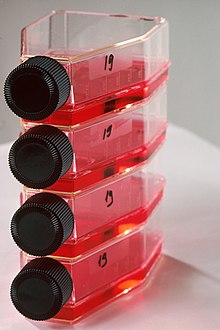Tissue culture is the growth of tissues and/or cells separate from the organism. This is typically facilitated via use of a liquid, semi-solid, or solid growth medium, such as broth or agar. Tissue culture commonly refers to the culture of animal cells and tissues, while the more specific term plant tissue culture is being named for the plants.
In 1907 the zoologist Ross Granville Harrison demonstrated the growth of frog nerve cell processes in a medium of clotted lymph.
In 1913, E. Steinhardt, C. Israeli, and R. A. Lambert grew vaccinia virus in fragments of guinea pig corneal tissue.[1]
However, "tissue culture" can also be used to refer to the culturing of tissue pieces, i.e. explant culture or whole organs, i.e. organ culture.
It is a tool for the study of animal cell biology in vitro model of cell growth to allow a highly selective environment which is easily manipulated (used to optimize cell signaling pathways).
Contents
|
Historical usage
In 1885 Wilhelm Roux removed a section of the medullary plate of an embryonic chicken and maintained it in a warm saline solution for several days, establishing the basic principle of tissue culture.In 1907 the zoologist Ross Granville Harrison demonstrated the growth of frog nerve cell processes in a medium of clotted lymph.
In 1913, E. Steinhardt, C. Israeli, and R. A. Lambert grew vaccinia virus in fragments of guinea pig corneal tissue.[1]
Modern usage
In modern usage, "tissue culture" generally refers to the growth of eukaryotic cells in vitro. It is often used interchangeably with cell culture to specifically describe the in vitro culturing of sperm donor cells.However, "tissue culture" can also be used to refer to the culturing of tissue pieces, i.e. explant culture or whole organs, i.e. organ culture.
It is a tool for the study of animal cell biology in vitro model of cell growth to allow a highly selective environment which is easily manipulated (used to optimize cell signaling pathways).


No comments:
Post a Comment